Primark's Strategic Position: An Economic and Policy Impact Analysis
VerifiedAdded on 2023/06/18
|10
|3257
|87
Essay
AI Summary
This essay provides an economic analysis of Primark, a fashion retailer operating in a monopolistic competitive market. It discusses Primark's mission statement, vision statement, and statement of values, emphasizing the importance of providing high-quality fashion at nominal prices. The essay analyzes the mechanisms underpinning Primark's pricing and output decisions, considering factors such as marginal cost and revenue. It also evaluates the impact of expansionary and contractionary fiscal and monetary policies on the company, explaining how these policies affect aggregate demand and product pricing. The analysis includes the effect of these policies on Primark's demand curve, pricing strategies, and overall profitability within its competitive market.
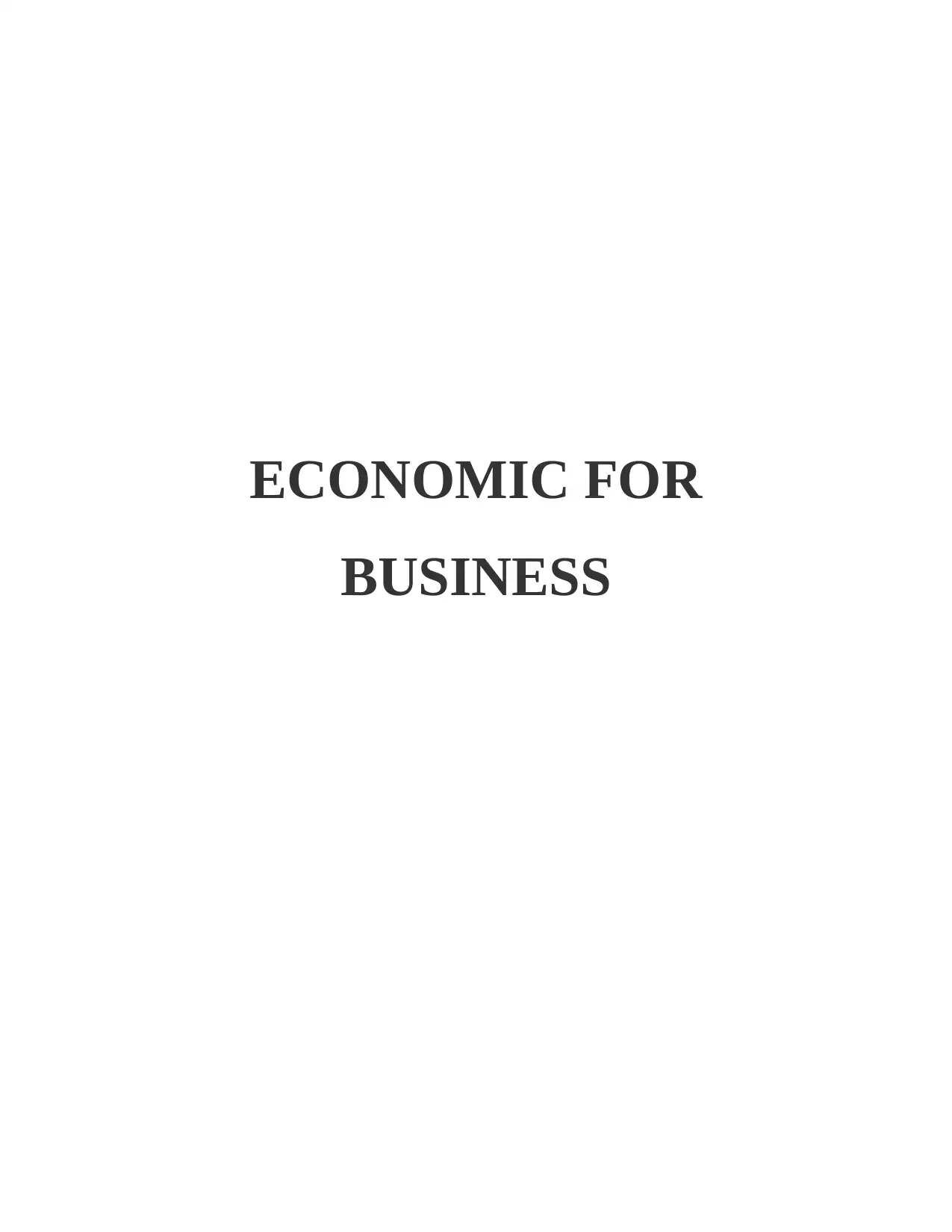
ECONOMIC FOR
BUSINESS
BUSINESS
Paraphrase This Document
Need a fresh take? Get an instant paraphrase of this document with our AI Paraphraser
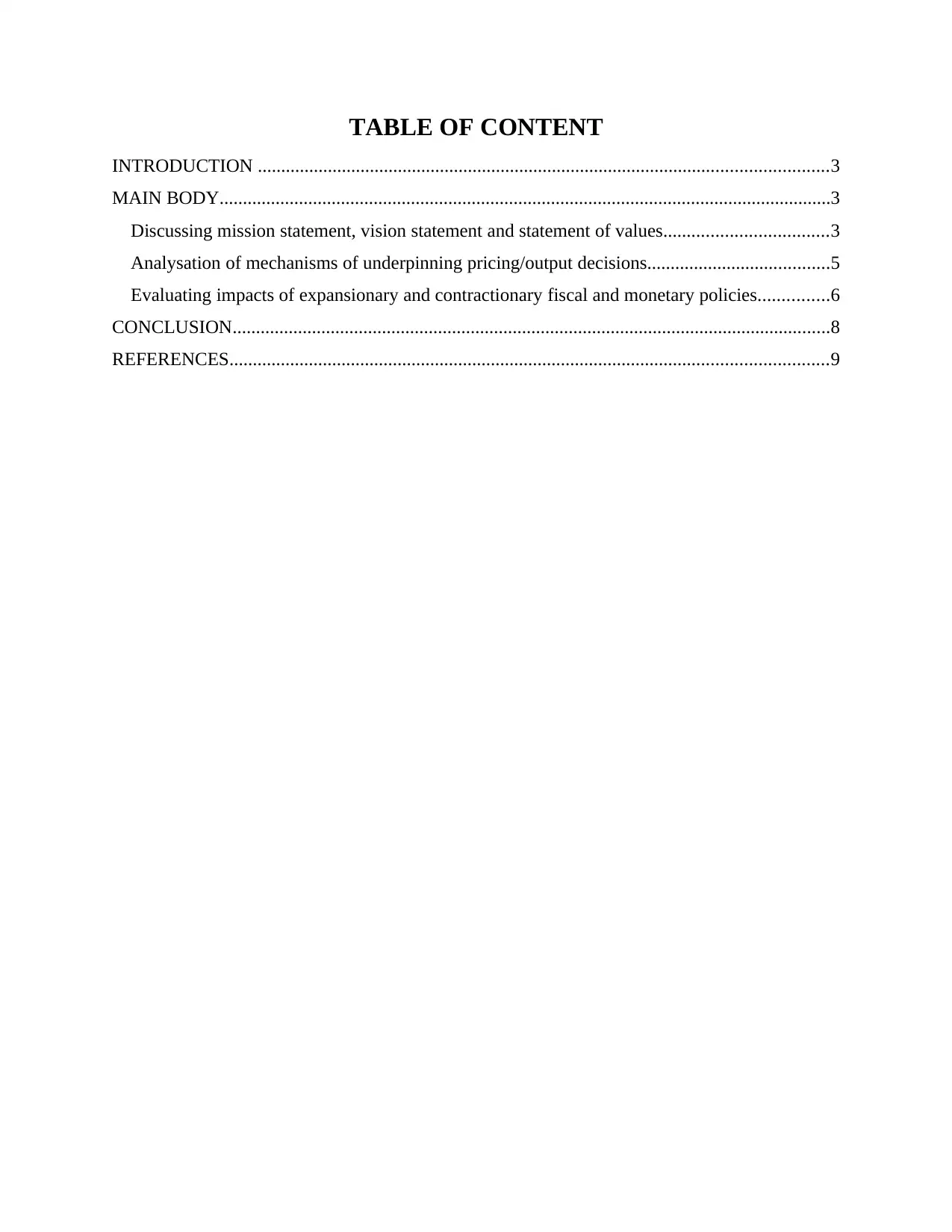
TABLE OF CONTENT
INTRODUCTION ..........................................................................................................................3
MAIN BODY...................................................................................................................................3
Discussing mission statement, vision statement and statement of values...................................3
Analysation of mechanisms of underpinning pricing/output decisions.......................................5
Evaluating impacts of expansionary and contractionary fiscal and monetary policies...............6
CONCLUSION................................................................................................................................8
REFERENCES................................................................................................................................9
INTRODUCTION ..........................................................................................................................3
MAIN BODY...................................................................................................................................3
Discussing mission statement, vision statement and statement of values...................................3
Analysation of mechanisms of underpinning pricing/output decisions.......................................5
Evaluating impacts of expansionary and contractionary fiscal and monetary policies...............6
CONCLUSION................................................................................................................................8
REFERENCES................................................................................................................................9
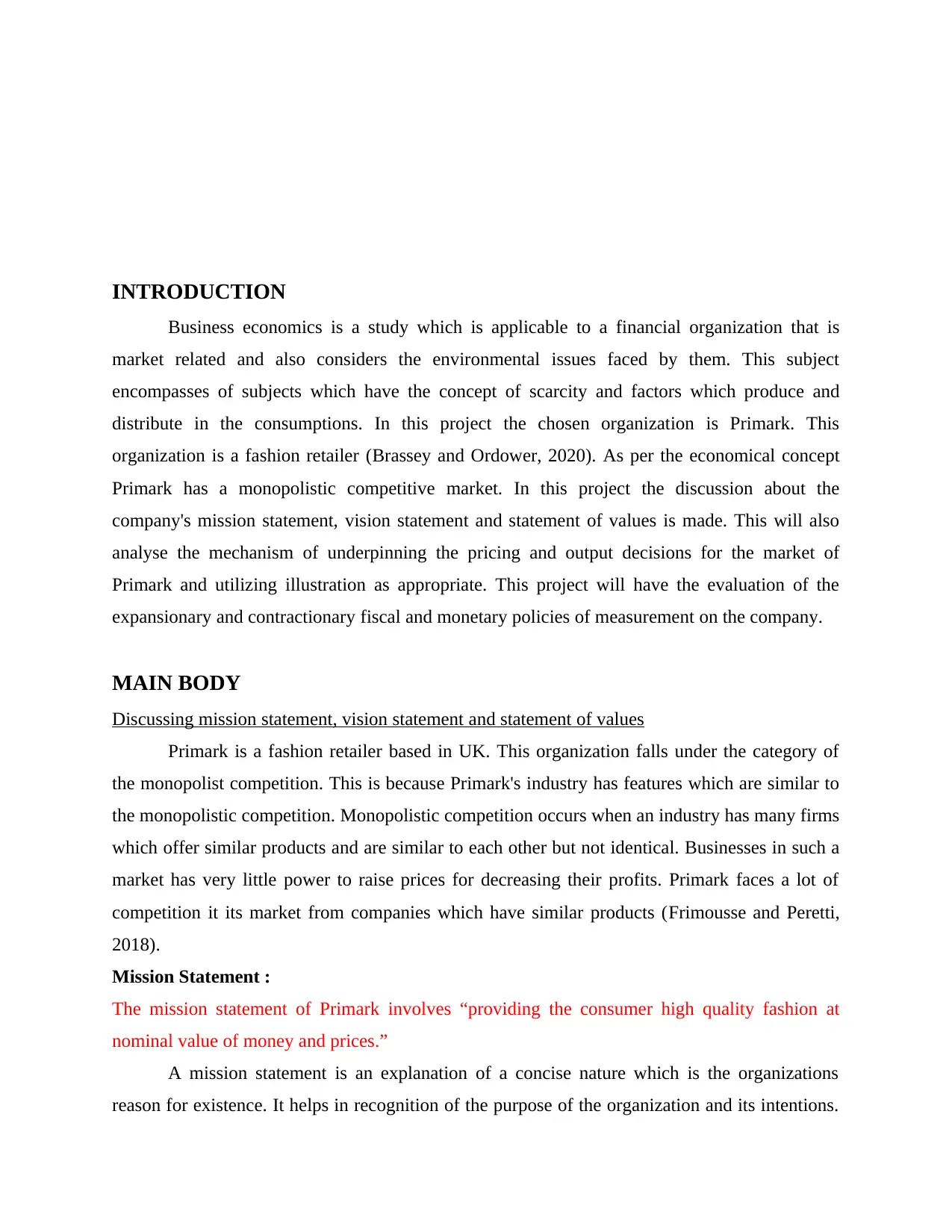
INTRODUCTION
Business economics is a study which is applicable to a financial organization that is
market related and also considers the environmental issues faced by them. This subject
encompasses of subjects which have the concept of scarcity and factors which produce and
distribute in the consumptions. In this project the chosen organization is Primark. This
organization is a fashion retailer (Brassey and Ordower, 2020). As per the economical concept
Primark has a monopolistic competitive market. In this project the discussion about the
company's mission statement, vision statement and statement of values is made. This will also
analyse the mechanism of underpinning the pricing and output decisions for the market of
Primark and utilizing illustration as appropriate. This project will have the evaluation of the
expansionary and contractionary fiscal and monetary policies of measurement on the company.
MAIN BODY
Discussing mission statement, vision statement and statement of values
Primark is a fashion retailer based in UK. This organization falls under the category of
the monopolist competition. This is because Primark's industry has features which are similar to
the monopolistic competition. Monopolistic competition occurs when an industry has many firms
which offer similar products and are similar to each other but not identical. Businesses in such a
market has very little power to raise prices for decreasing their profits. Primark faces a lot of
competition it its market from companies which have similar products (Frimousse and Peretti,
2018).
Mission Statement :
The mission statement of Primark involves “providing the consumer high quality fashion at
nominal value of money and prices.”
A mission statement is an explanation of a concise nature which is the organizations
reason for existence. It helps in recognition of the purpose of the organization and its intentions.
Business economics is a study which is applicable to a financial organization that is
market related and also considers the environmental issues faced by them. This subject
encompasses of subjects which have the concept of scarcity and factors which produce and
distribute in the consumptions. In this project the chosen organization is Primark. This
organization is a fashion retailer (Brassey and Ordower, 2020). As per the economical concept
Primark has a monopolistic competitive market. In this project the discussion about the
company's mission statement, vision statement and statement of values is made. This will also
analyse the mechanism of underpinning the pricing and output decisions for the market of
Primark and utilizing illustration as appropriate. This project will have the evaluation of the
expansionary and contractionary fiscal and monetary policies of measurement on the company.
MAIN BODY
Discussing mission statement, vision statement and statement of values
Primark is a fashion retailer based in UK. This organization falls under the category of
the monopolist competition. This is because Primark's industry has features which are similar to
the monopolistic competition. Monopolistic competition occurs when an industry has many firms
which offer similar products and are similar to each other but not identical. Businesses in such a
market has very little power to raise prices for decreasing their profits. Primark faces a lot of
competition it its market from companies which have similar products (Frimousse and Peretti,
2018).
Mission Statement :
The mission statement of Primark involves “providing the consumer high quality fashion at
nominal value of money and prices.”
A mission statement is an explanation of a concise nature which is the organizations
reason for existence. It helps in recognition of the purpose of the organization and its intentions.
⊘ This is a preview!⊘
Do you want full access?
Subscribe today to unlock all pages.

Trusted by 1+ million students worldwide
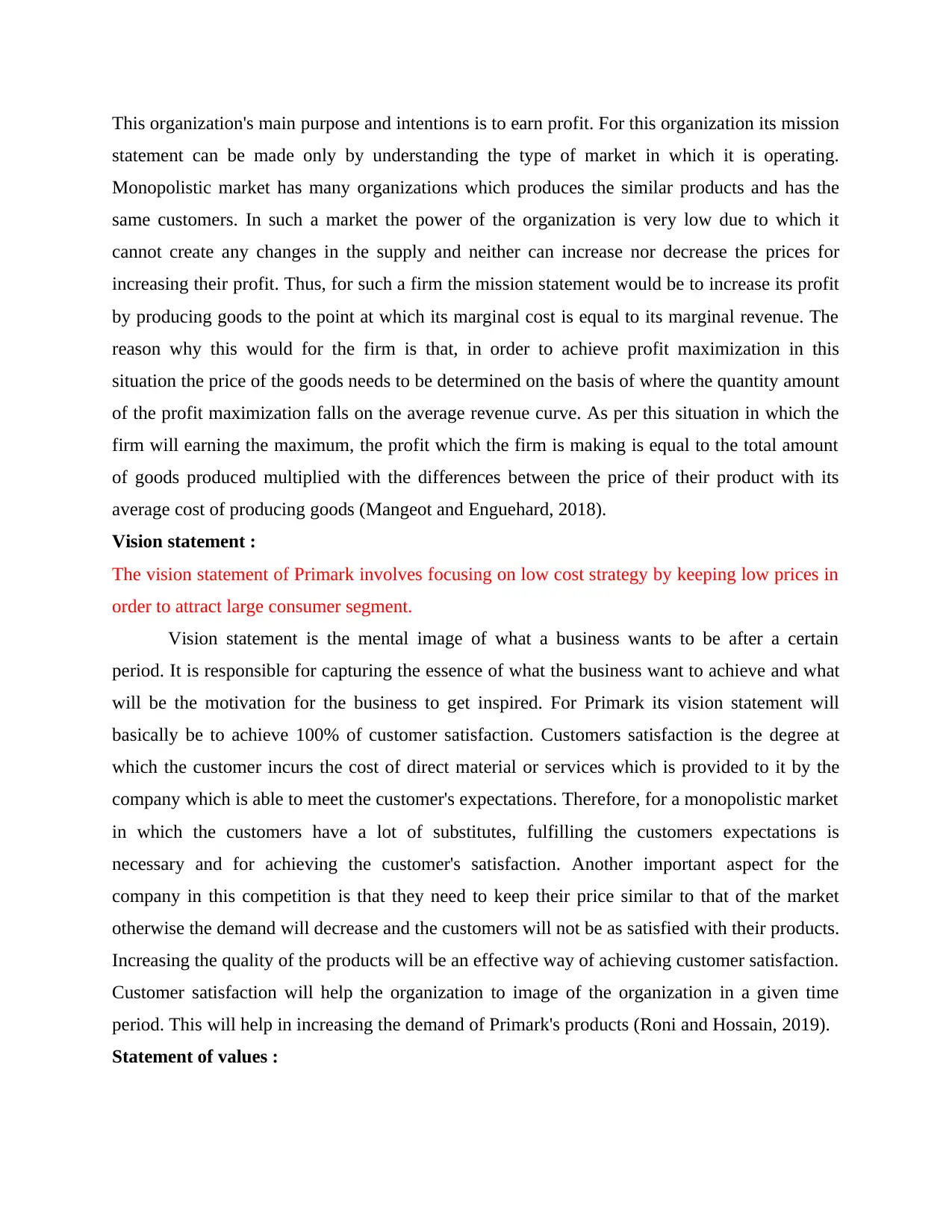
This organization's main purpose and intentions is to earn profit. For this organization its mission
statement can be made only by understanding the type of market in which it is operating.
Monopolistic market has many organizations which produces the similar products and has the
same customers. In such a market the power of the organization is very low due to which it
cannot create any changes in the supply and neither can increase nor decrease the prices for
increasing their profit. Thus, for such a firm the mission statement would be to increase its profit
by producing goods to the point at which its marginal cost is equal to its marginal revenue. The
reason why this would for the firm is that, in order to achieve profit maximization in this
situation the price of the goods needs to be determined on the basis of where the quantity amount
of the profit maximization falls on the average revenue curve. As per this situation in which the
firm will earning the maximum, the profit which the firm is making is equal to the total amount
of goods produced multiplied with the differences between the price of their product with its
average cost of producing goods (Mangeot and Enguehard, 2018).
Vision statement :
The vision statement of Primark involves focusing on low cost strategy by keeping low prices in
order to attract large consumer segment.
Vision statement is the mental image of what a business wants to be after a certain
period. It is responsible for capturing the essence of what the business want to achieve and what
will be the motivation for the business to get inspired. For Primark its vision statement will
basically be to achieve 100% of customer satisfaction. Customers satisfaction is the degree at
which the customer incurs the cost of direct material or services which is provided to it by the
company which is able to meet the customer's expectations. Therefore, for a monopolistic market
in which the customers have a lot of substitutes, fulfilling the customers expectations is
necessary and for achieving the customer's satisfaction. Another important aspect for the
company in this competition is that they need to keep their price similar to that of the market
otherwise the demand will decrease and the customers will not be as satisfied with their products.
Increasing the quality of the products will be an effective way of achieving customer satisfaction.
Customer satisfaction will help the organization to image of the organization in a given time
period. This will help in increasing the demand of Primark's products (Roni and Hossain, 2019).
Statement of values :
statement can be made only by understanding the type of market in which it is operating.
Monopolistic market has many organizations which produces the similar products and has the
same customers. In such a market the power of the organization is very low due to which it
cannot create any changes in the supply and neither can increase nor decrease the prices for
increasing their profit. Thus, for such a firm the mission statement would be to increase its profit
by producing goods to the point at which its marginal cost is equal to its marginal revenue. The
reason why this would for the firm is that, in order to achieve profit maximization in this
situation the price of the goods needs to be determined on the basis of where the quantity amount
of the profit maximization falls on the average revenue curve. As per this situation in which the
firm will earning the maximum, the profit which the firm is making is equal to the total amount
of goods produced multiplied with the differences between the price of their product with its
average cost of producing goods (Mangeot and Enguehard, 2018).
Vision statement :
The vision statement of Primark involves focusing on low cost strategy by keeping low prices in
order to attract large consumer segment.
Vision statement is the mental image of what a business wants to be after a certain
period. It is responsible for capturing the essence of what the business want to achieve and what
will be the motivation for the business to get inspired. For Primark its vision statement will
basically be to achieve 100% of customer satisfaction. Customers satisfaction is the degree at
which the customer incurs the cost of direct material or services which is provided to it by the
company which is able to meet the customer's expectations. Therefore, for a monopolistic market
in which the customers have a lot of substitutes, fulfilling the customers expectations is
necessary and for achieving the customer's satisfaction. Another important aspect for the
company in this competition is that they need to keep their price similar to that of the market
otherwise the demand will decrease and the customers will not be as satisfied with their products.
Increasing the quality of the products will be an effective way of achieving customer satisfaction.
Customer satisfaction will help the organization to image of the organization in a given time
period. This will help in increasing the demand of Primark's products (Roni and Hossain, 2019).
Statement of values :
Paraphrase This Document
Need a fresh take? Get an instant paraphrase of this document with our AI Paraphraser
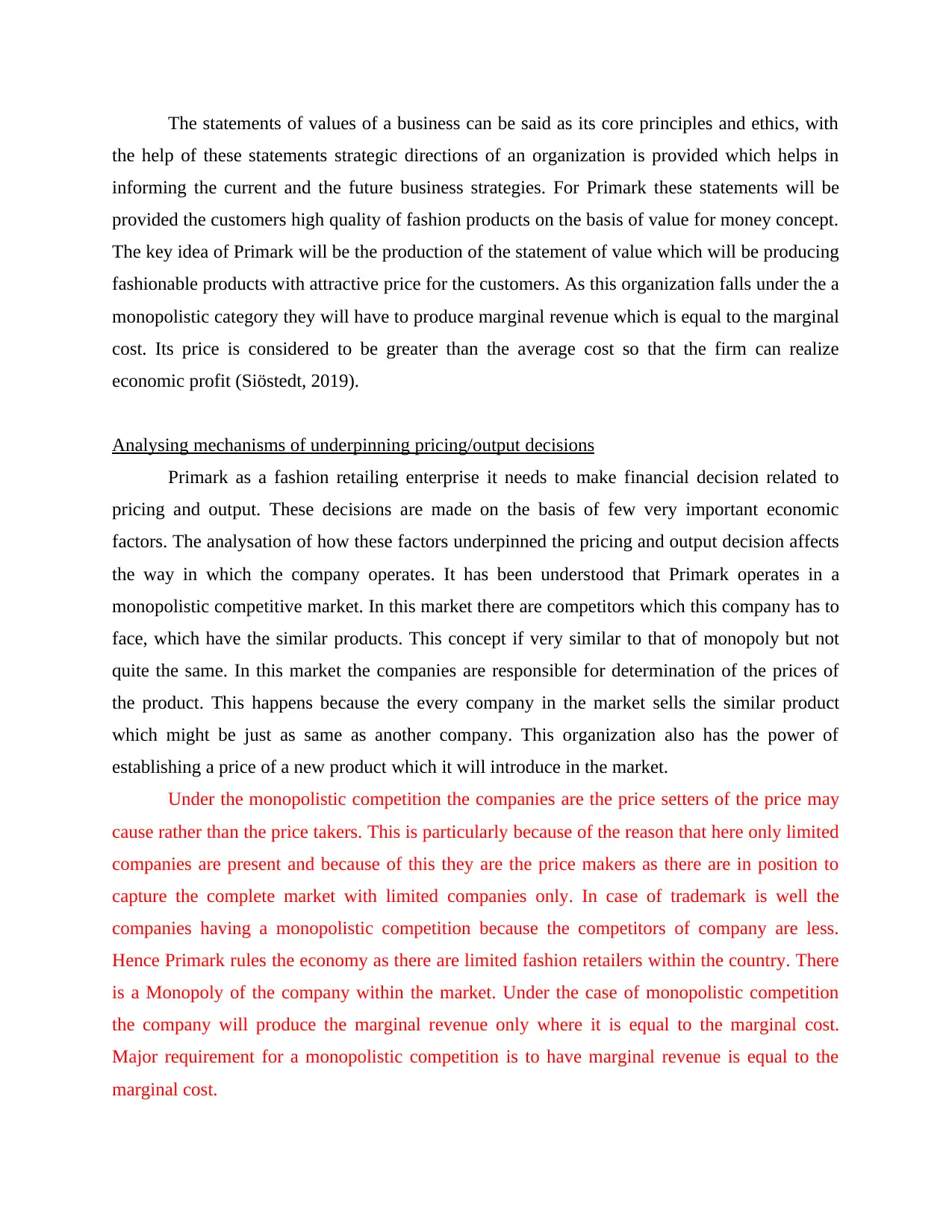
The statements of values of a business can be said as its core principles and ethics, with
the help of these statements strategic directions of an organization is provided which helps in
informing the current and the future business strategies. For Primark these statements will be
provided the customers high quality of fashion products on the basis of value for money concept.
The key idea of Primark will be the production of the statement of value which will be producing
fashionable products with attractive price for the customers. As this organization falls under the a
monopolistic category they will have to produce marginal revenue which is equal to the marginal
cost. Its price is considered to be greater than the average cost so that the firm can realize
economic profit (Siöstedt, 2019).
Analysing mechanisms of underpinning pricing/output decisions
Primark as a fashion retailing enterprise it needs to make financial decision related to
pricing and output. These decisions are made on the basis of few very important economic
factors. The analysation of how these factors underpinned the pricing and output decision affects
the way in which the company operates. It has been understood that Primark operates in a
monopolistic competitive market. In this market there are competitors which this company has to
face, which have the similar products. This concept if very similar to that of monopoly but not
quite the same. In this market the companies are responsible for determination of the prices of
the product. This happens because the every company in the market sells the similar product
which might be just as same as another company. This organization also has the power of
establishing a price of a new product which it will introduce in the market.
Under the monopolistic competition the companies are the price setters of the price may
cause rather than the price takers. This is particularly because of the reason that here only limited
companies are present and because of this they are the price makers as there are in position to
capture the complete market with limited companies only. In case of trademark is well the
companies having a monopolistic competition because the competitors of company are less.
Hence Primark rules the economy as there are limited fashion retailers within the country. There
is a Monopoly of the company within the market. Under the case of monopolistic competition
the company will produce the marginal revenue only where it is equal to the marginal cost.
Major requirement for a monopolistic competition is to have marginal revenue is equal to the
marginal cost.
the help of these statements strategic directions of an organization is provided which helps in
informing the current and the future business strategies. For Primark these statements will be
provided the customers high quality of fashion products on the basis of value for money concept.
The key idea of Primark will be the production of the statement of value which will be producing
fashionable products with attractive price for the customers. As this organization falls under the a
monopolistic category they will have to produce marginal revenue which is equal to the marginal
cost. Its price is considered to be greater than the average cost so that the firm can realize
economic profit (Siöstedt, 2019).
Analysing mechanisms of underpinning pricing/output decisions
Primark as a fashion retailing enterprise it needs to make financial decision related to
pricing and output. These decisions are made on the basis of few very important economic
factors. The analysation of how these factors underpinned the pricing and output decision affects
the way in which the company operates. It has been understood that Primark operates in a
monopolistic competitive market. In this market there are competitors which this company has to
face, which have the similar products. This concept if very similar to that of monopoly but not
quite the same. In this market the companies are responsible for determination of the prices of
the product. This happens because the every company in the market sells the similar product
which might be just as same as another company. This organization also has the power of
establishing a price of a new product which it will introduce in the market.
Under the monopolistic competition the companies are the price setters of the price may
cause rather than the price takers. This is particularly because of the reason that here only limited
companies are present and because of this they are the price makers as there are in position to
capture the complete market with limited companies only. In case of trademark is well the
companies having a monopolistic competition because the competitors of company are less.
Hence Primark rules the economy as there are limited fashion retailers within the country. There
is a Monopoly of the company within the market. Under the case of monopolistic competition
the company will produce the marginal revenue only where it is equal to the marginal cost.
Major requirement for a monopolistic competition is to have marginal revenue is equal to the
marginal cost.
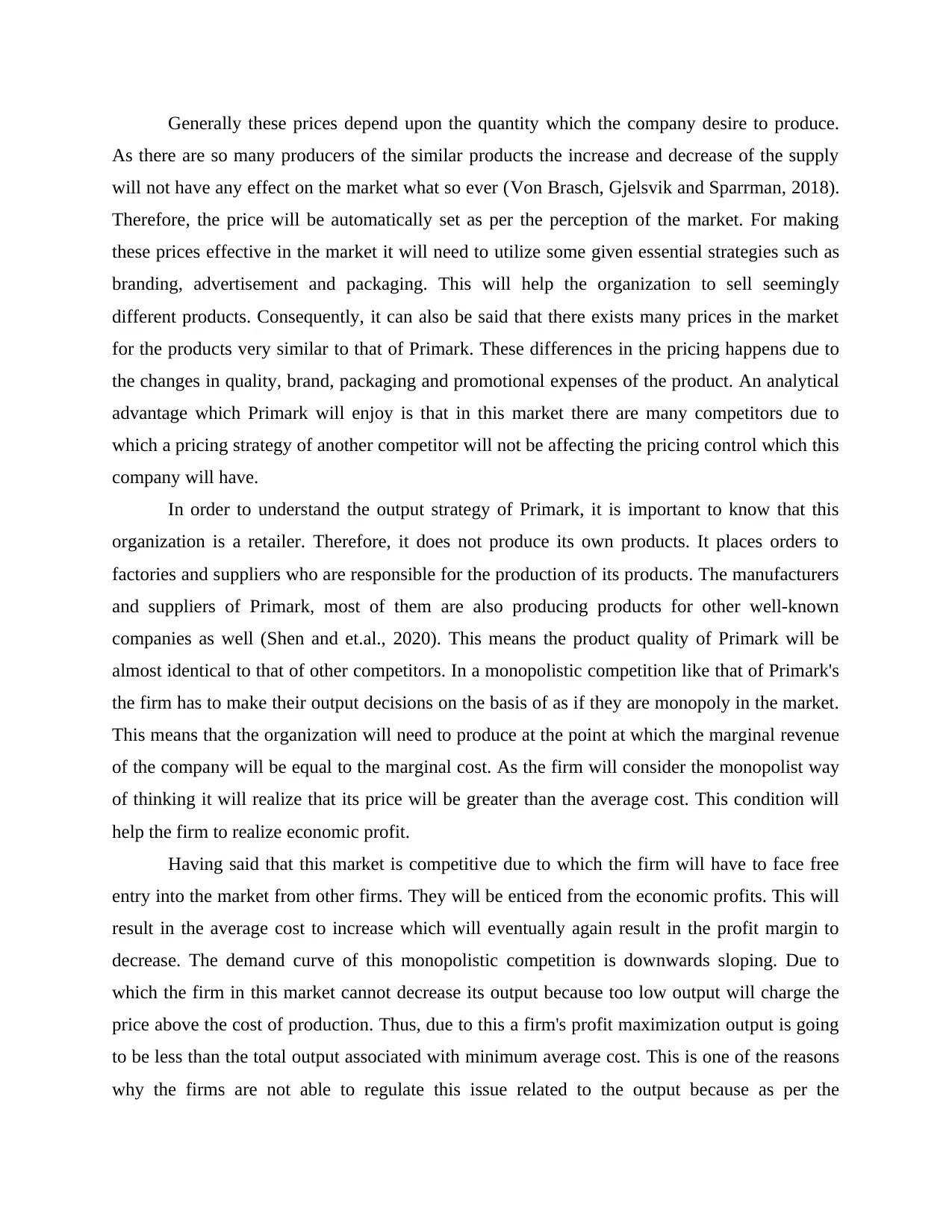
Generally these prices depend upon the quantity which the company desire to produce.
As there are so many producers of the similar products the increase and decrease of the supply
will not have any effect on the market what so ever (Von Brasch, Gjelsvik and Sparrman, 2018).
Therefore, the price will be automatically set as per the perception of the market. For making
these prices effective in the market it will need to utilize some given essential strategies such as
branding, advertisement and packaging. This will help the organization to sell seemingly
different products. Consequently, it can also be said that there exists many prices in the market
for the products very similar to that of Primark. These differences in the pricing happens due to
the changes in quality, brand, packaging and promotional expenses of the product. An analytical
advantage which Primark will enjoy is that in this market there are many competitors due to
which a pricing strategy of another competitor will not be affecting the pricing control which this
company will have.
In order to understand the output strategy of Primark, it is important to know that this
organization is a retailer. Therefore, it does not produce its own products. It places orders to
factories and suppliers who are responsible for the production of its products. The manufacturers
and suppliers of Primark, most of them are also producing products for other well-known
companies as well (Shen and et.al., 2020). This means the product quality of Primark will be
almost identical to that of other competitors. In a monopolistic competition like that of Primark's
the firm has to make their output decisions on the basis of as if they are monopoly in the market.
This means that the organization will need to produce at the point at which the marginal revenue
of the company will be equal to the marginal cost. As the firm will consider the monopolist way
of thinking it will realize that its price will be greater than the average cost. This condition will
help the firm to realize economic profit.
Having said that this market is competitive due to which the firm will have to face free
entry into the market from other firms. They will be enticed from the economic profits. This will
result in the average cost to increase which will eventually again result in the profit margin to
decrease. The demand curve of this monopolistic competition is downwards sloping. Due to
which the firm in this market cannot decrease its output because too low output will charge the
price above the cost of production. Thus, due to this a firm's profit maximization output is going
to be less than the total output associated with minimum average cost. This is one of the reasons
why the firms are not able to regulate this issue related to the output because as per the
As there are so many producers of the similar products the increase and decrease of the supply
will not have any effect on the market what so ever (Von Brasch, Gjelsvik and Sparrman, 2018).
Therefore, the price will be automatically set as per the perception of the market. For making
these prices effective in the market it will need to utilize some given essential strategies such as
branding, advertisement and packaging. This will help the organization to sell seemingly
different products. Consequently, it can also be said that there exists many prices in the market
for the products very similar to that of Primark. These differences in the pricing happens due to
the changes in quality, brand, packaging and promotional expenses of the product. An analytical
advantage which Primark will enjoy is that in this market there are many competitors due to
which a pricing strategy of another competitor will not be affecting the pricing control which this
company will have.
In order to understand the output strategy of Primark, it is important to know that this
organization is a retailer. Therefore, it does not produce its own products. It places orders to
factories and suppliers who are responsible for the production of its products. The manufacturers
and suppliers of Primark, most of them are also producing products for other well-known
companies as well (Shen and et.al., 2020). This means the product quality of Primark will be
almost identical to that of other competitors. In a monopolistic competition like that of Primark's
the firm has to make their output decisions on the basis of as if they are monopoly in the market.
This means that the organization will need to produce at the point at which the marginal revenue
of the company will be equal to the marginal cost. As the firm will consider the monopolist way
of thinking it will realize that its price will be greater than the average cost. This condition will
help the firm to realize economic profit.
Having said that this market is competitive due to which the firm will have to face free
entry into the market from other firms. They will be enticed from the economic profits. This will
result in the average cost to increase which will eventually again result in the profit margin to
decrease. The demand curve of this monopolistic competition is downwards sloping. Due to
which the firm in this market cannot decrease its output because too low output will charge the
price above the cost of production. Thus, due to this a firm's profit maximization output is going
to be less than the total output associated with minimum average cost. This is one of the reasons
why the firms are not able to regulate this issue related to the output because as per the
⊘ This is a preview!⊘
Do you want full access?
Subscribe today to unlock all pages.

Trusted by 1+ million students worldwide
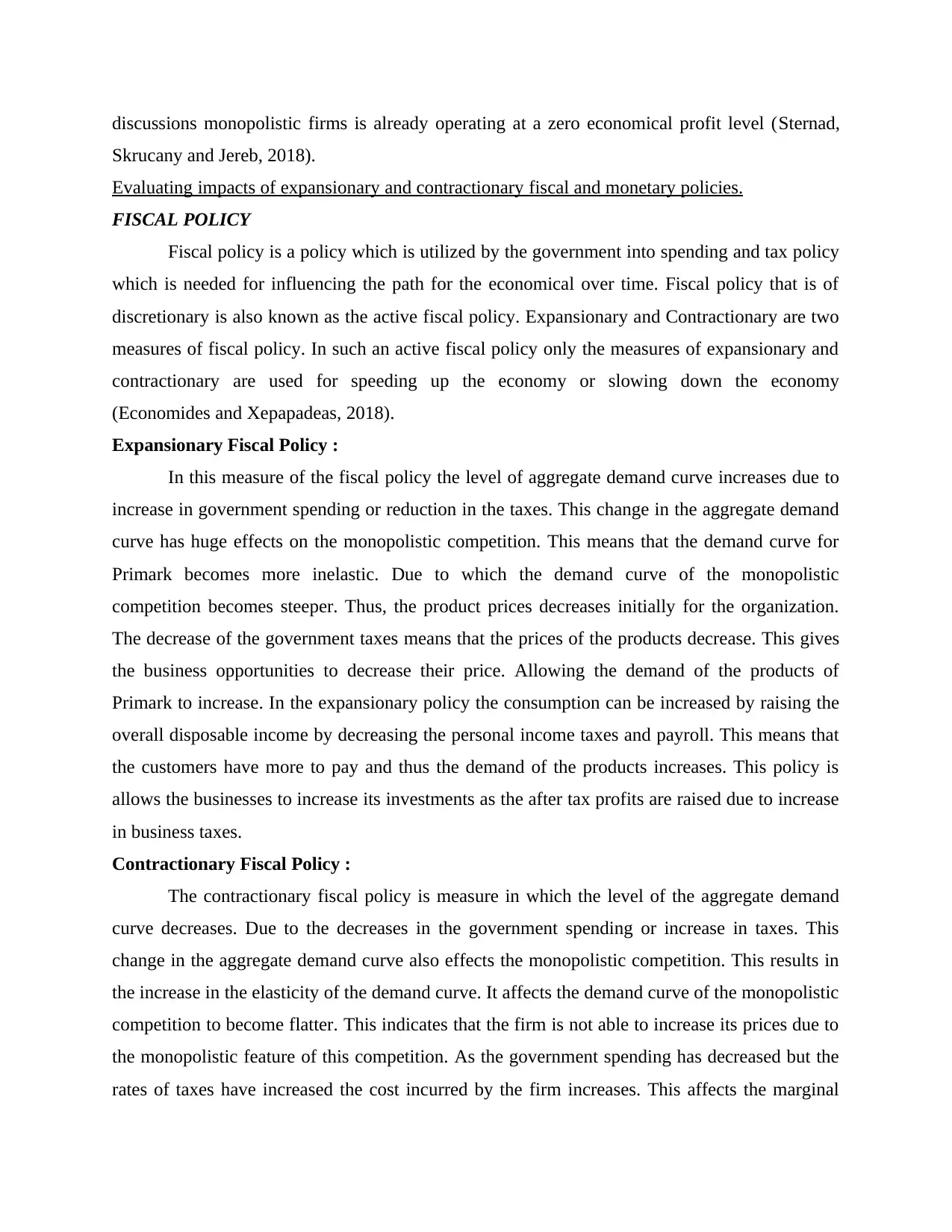
discussions monopolistic firms is already operating at a zero economical profit level (Sternad,
Skrucany and Jereb, 2018).
Evaluating impacts of expansionary and contractionary fiscal and monetary policies.
FISCAL POLICY
Fiscal policy is a policy which is utilized by the government into spending and tax policy
which is needed for influencing the path for the economical over time. Fiscal policy that is of
discretionary is also known as the active fiscal policy. Expansionary and Contractionary are two
measures of fiscal policy. In such an active fiscal policy only the measures of expansionary and
contractionary are used for speeding up the economy or slowing down the economy
(Economides and Xepapadeas, 2018).
Expansionary Fiscal Policy :
In this measure of the fiscal policy the level of aggregate demand curve increases due to
increase in government spending or reduction in the taxes. This change in the aggregate demand
curve has huge effects on the monopolistic competition. This means that the demand curve for
Primark becomes more inelastic. Due to which the demand curve of the monopolistic
competition becomes steeper. Thus, the product prices decreases initially for the organization.
The decrease of the government taxes means that the prices of the products decrease. This gives
the business opportunities to decrease their price. Allowing the demand of the products of
Primark to increase. In the expansionary policy the consumption can be increased by raising the
overall disposable income by decreasing the personal income taxes and payroll. This means that
the customers have more to pay and thus the demand of the products increases. This policy is
allows the businesses to increase its investments as the after tax profits are raised due to increase
in business taxes.
Contractionary Fiscal Policy :
The contractionary fiscal policy is measure in which the level of the aggregate demand
curve decreases. Due to the decreases in the government spending or increase in taxes. This
change in the aggregate demand curve also effects the monopolistic competition. This results in
the increase in the elasticity of the demand curve. It affects the demand curve of the monopolistic
competition to become flatter. This indicates that the firm is not able to increase its prices due to
the monopolistic feature of this competition. As the government spending has decreased but the
rates of taxes have increased the cost incurred by the firm increases. This affects the marginal
Skrucany and Jereb, 2018).
Evaluating impacts of expansionary and contractionary fiscal and monetary policies.
FISCAL POLICY
Fiscal policy is a policy which is utilized by the government into spending and tax policy
which is needed for influencing the path for the economical over time. Fiscal policy that is of
discretionary is also known as the active fiscal policy. Expansionary and Contractionary are two
measures of fiscal policy. In such an active fiscal policy only the measures of expansionary and
contractionary are used for speeding up the economy or slowing down the economy
(Economides and Xepapadeas, 2018).
Expansionary Fiscal Policy :
In this measure of the fiscal policy the level of aggregate demand curve increases due to
increase in government spending or reduction in the taxes. This change in the aggregate demand
curve has huge effects on the monopolistic competition. This means that the demand curve for
Primark becomes more inelastic. Due to which the demand curve of the monopolistic
competition becomes steeper. Thus, the product prices decreases initially for the organization.
The decrease of the government taxes means that the prices of the products decrease. This gives
the business opportunities to decrease their price. Allowing the demand of the products of
Primark to increase. In the expansionary policy the consumption can be increased by raising the
overall disposable income by decreasing the personal income taxes and payroll. This means that
the customers have more to pay and thus the demand of the products increases. This policy is
allows the businesses to increase its investments as the after tax profits are raised due to increase
in business taxes.
Contractionary Fiscal Policy :
The contractionary fiscal policy is measure in which the level of the aggregate demand
curve decreases. Due to the decreases in the government spending or increase in taxes. This
change in the aggregate demand curve also effects the monopolistic competition. This results in
the increase in the elasticity of the demand curve. It affects the demand curve of the monopolistic
competition to become flatter. This indicates that the firm is not able to increase its prices due to
the monopolistic feature of this competition. As the government spending has decreased but the
rates of taxes have increased the cost incurred by the firm increases. This affects the marginal
Paraphrase This Document
Need a fresh take? Get an instant paraphrase of this document with our AI Paraphraser
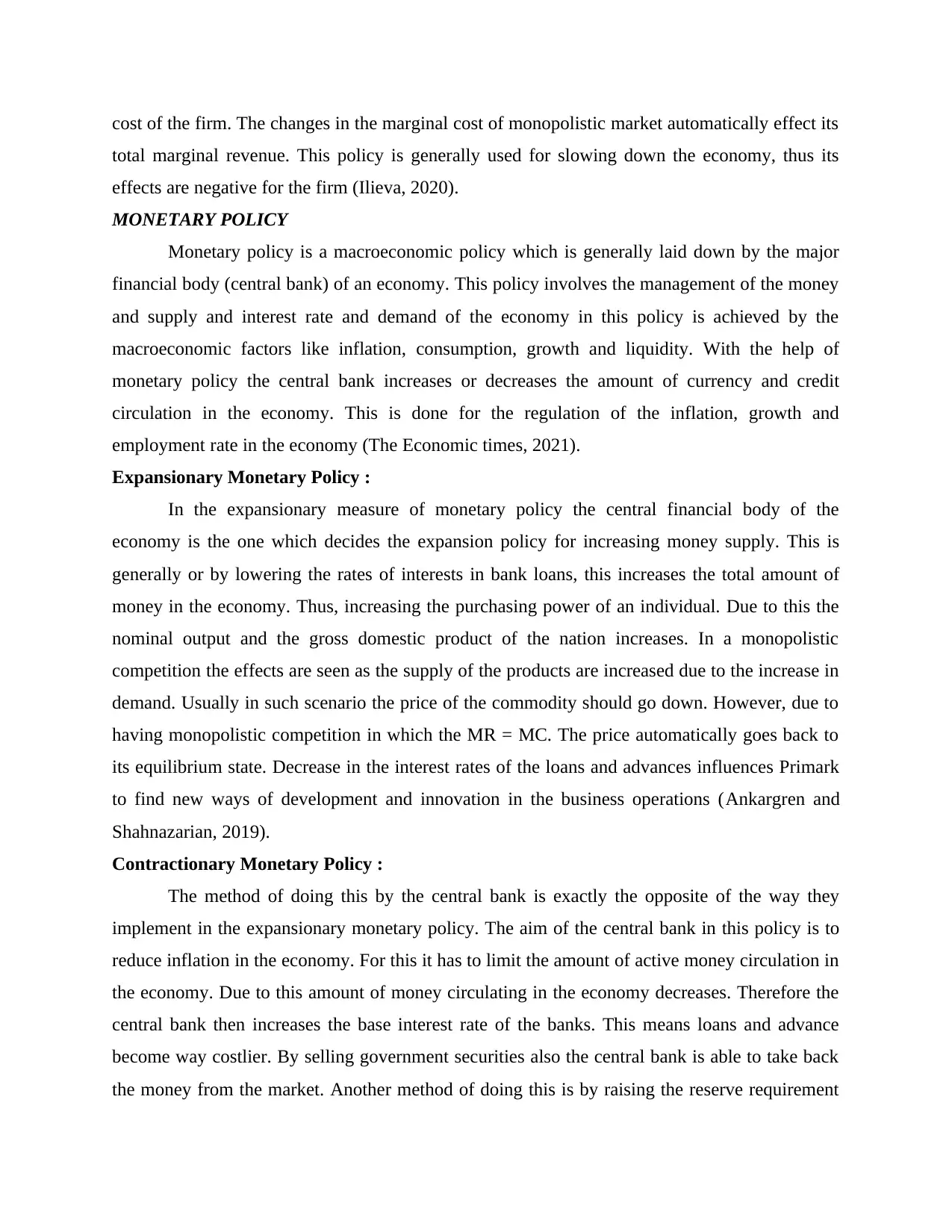
cost of the firm. The changes in the marginal cost of monopolistic market automatically effect its
total marginal revenue. This policy is generally used for slowing down the economy, thus its
effects are negative for the firm (Ilieva, 2020).
MONETARY POLICY
Monetary policy is a macroeconomic policy which is generally laid down by the major
financial body (central bank) of an economy. This policy involves the management of the money
and supply and interest rate and demand of the economy in this policy is achieved by the
macroeconomic factors like inflation, consumption, growth and liquidity. With the help of
monetary policy the central bank increases or decreases the amount of currency and credit
circulation in the economy. This is done for the regulation of the inflation, growth and
employment rate in the economy (The Economic times, 2021).
Expansionary Monetary Policy :
In the expansionary measure of monetary policy the central financial body of the
economy is the one which decides the expansion policy for increasing money supply. This is
generally or by lowering the rates of interests in bank loans, this increases the total amount of
money in the economy. Thus, increasing the purchasing power of an individual. Due to this the
nominal output and the gross domestic product of the nation increases. In a monopolistic
competition the effects are seen as the supply of the products are increased due to the increase in
demand. Usually in such scenario the price of the commodity should go down. However, due to
having monopolistic competition in which the MR = MC. The price automatically goes back to
its equilibrium state. Decrease in the interest rates of the loans and advances influences Primark
to find new ways of development and innovation in the business operations (Ankargren and
Shahnazarian, 2019).
Contractionary Monetary Policy :
The method of doing this by the central bank is exactly the opposite of the way they
implement in the expansionary monetary policy. The aim of the central bank in this policy is to
reduce inflation in the economy. For this it has to limit the amount of active money circulation in
the economy. Due to this amount of money circulating in the economy decreases. Therefore the
central bank then increases the base interest rate of the banks. This means loans and advance
become way costlier. By selling government securities also the central bank is able to take back
the money from the market. Another method of doing this is by raising the reserve requirement
total marginal revenue. This policy is generally used for slowing down the economy, thus its
effects are negative for the firm (Ilieva, 2020).
MONETARY POLICY
Monetary policy is a macroeconomic policy which is generally laid down by the major
financial body (central bank) of an economy. This policy involves the management of the money
and supply and interest rate and demand of the economy in this policy is achieved by the
macroeconomic factors like inflation, consumption, growth and liquidity. With the help of
monetary policy the central bank increases or decreases the amount of currency and credit
circulation in the economy. This is done for the regulation of the inflation, growth and
employment rate in the economy (The Economic times, 2021).
Expansionary Monetary Policy :
In the expansionary measure of monetary policy the central financial body of the
economy is the one which decides the expansion policy for increasing money supply. This is
generally or by lowering the rates of interests in bank loans, this increases the total amount of
money in the economy. Thus, increasing the purchasing power of an individual. Due to this the
nominal output and the gross domestic product of the nation increases. In a monopolistic
competition the effects are seen as the supply of the products are increased due to the increase in
demand. Usually in such scenario the price of the commodity should go down. However, due to
having monopolistic competition in which the MR = MC. The price automatically goes back to
its equilibrium state. Decrease in the interest rates of the loans and advances influences Primark
to find new ways of development and innovation in the business operations (Ankargren and
Shahnazarian, 2019).
Contractionary Monetary Policy :
The method of doing this by the central bank is exactly the opposite of the way they
implement in the expansionary monetary policy. The aim of the central bank in this policy is to
reduce inflation in the economy. For this it has to limit the amount of active money circulation in
the economy. Due to this amount of money circulating in the economy decreases. Therefore the
central bank then increases the base interest rate of the banks. This means loans and advance
become way costlier. By selling government securities also the central bank is able to take back
the money from the market. Another method of doing this is by raising the reserve requirement
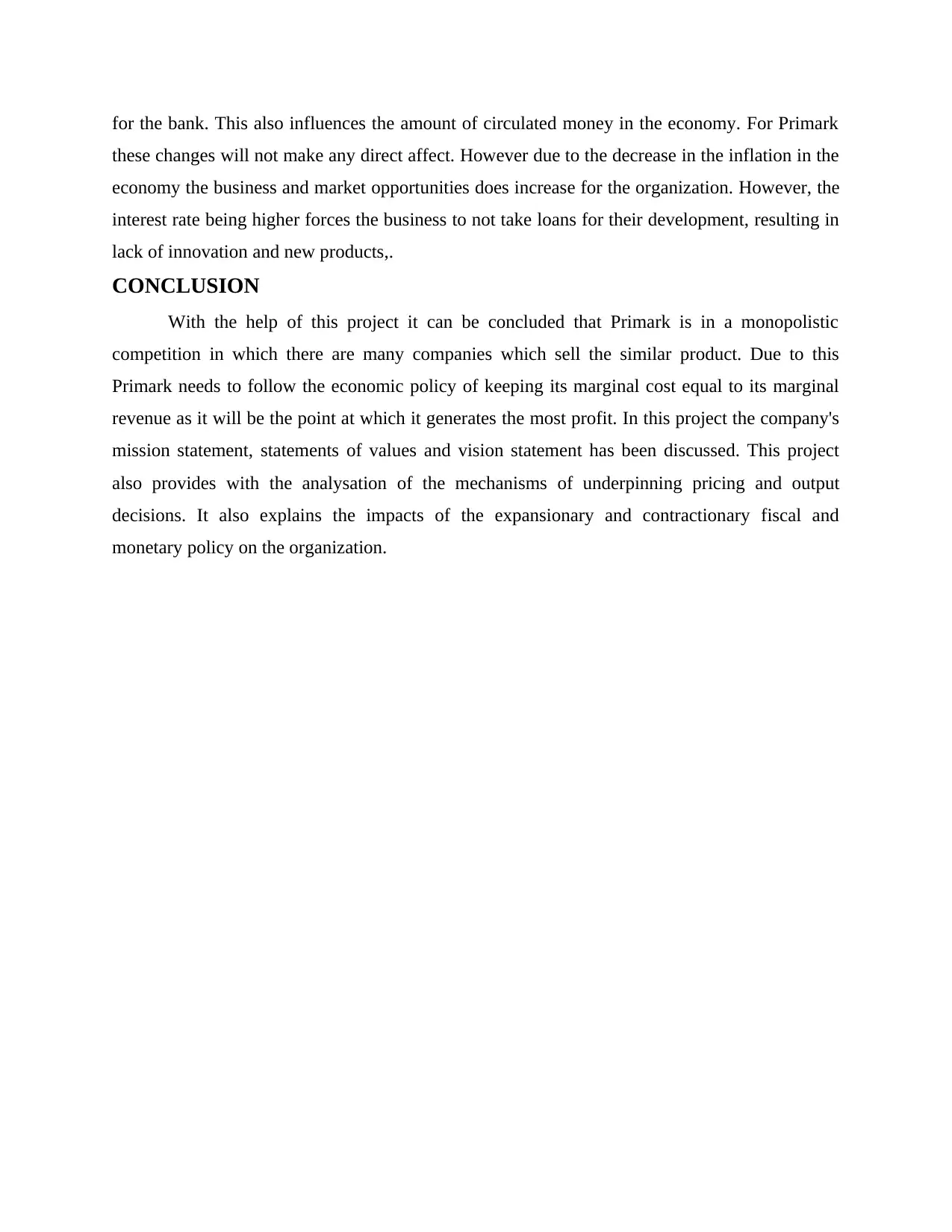
for the bank. This also influences the amount of circulated money in the economy. For Primark
these changes will not make any direct affect. However due to the decrease in the inflation in the
economy the business and market opportunities does increase for the organization. However, the
interest rate being higher forces the business to not take loans for their development, resulting in
lack of innovation and new products,.
CONCLUSION
With the help of this project it can be concluded that Primark is in a monopolistic
competition in which there are many companies which sell the similar product. Due to this
Primark needs to follow the economic policy of keeping its marginal cost equal to its marginal
revenue as it will be the point at which it generates the most profit. In this project the company's
mission statement, statements of values and vision statement has been discussed. This project
also provides with the analysation of the mechanisms of underpinning pricing and output
decisions. It also explains the impacts of the expansionary and contractionary fiscal and
monetary policy on the organization.
these changes will not make any direct affect. However due to the decrease in the inflation in the
economy the business and market opportunities does increase for the organization. However, the
interest rate being higher forces the business to not take loans for their development, resulting in
lack of innovation and new products,.
CONCLUSION
With the help of this project it can be concluded that Primark is in a monopolistic
competition in which there are many companies which sell the similar product. Due to this
Primark needs to follow the economic policy of keeping its marginal cost equal to its marginal
revenue as it will be the point at which it generates the most profit. In this project the company's
mission statement, statements of values and vision statement has been discussed. This project
also provides with the analysation of the mechanisms of underpinning pricing and output
decisions. It also explains the impacts of the expansionary and contractionary fiscal and
monetary policy on the organization.
⊘ This is a preview!⊘
Do you want full access?
Subscribe today to unlock all pages.

Trusted by 1+ million students worldwide
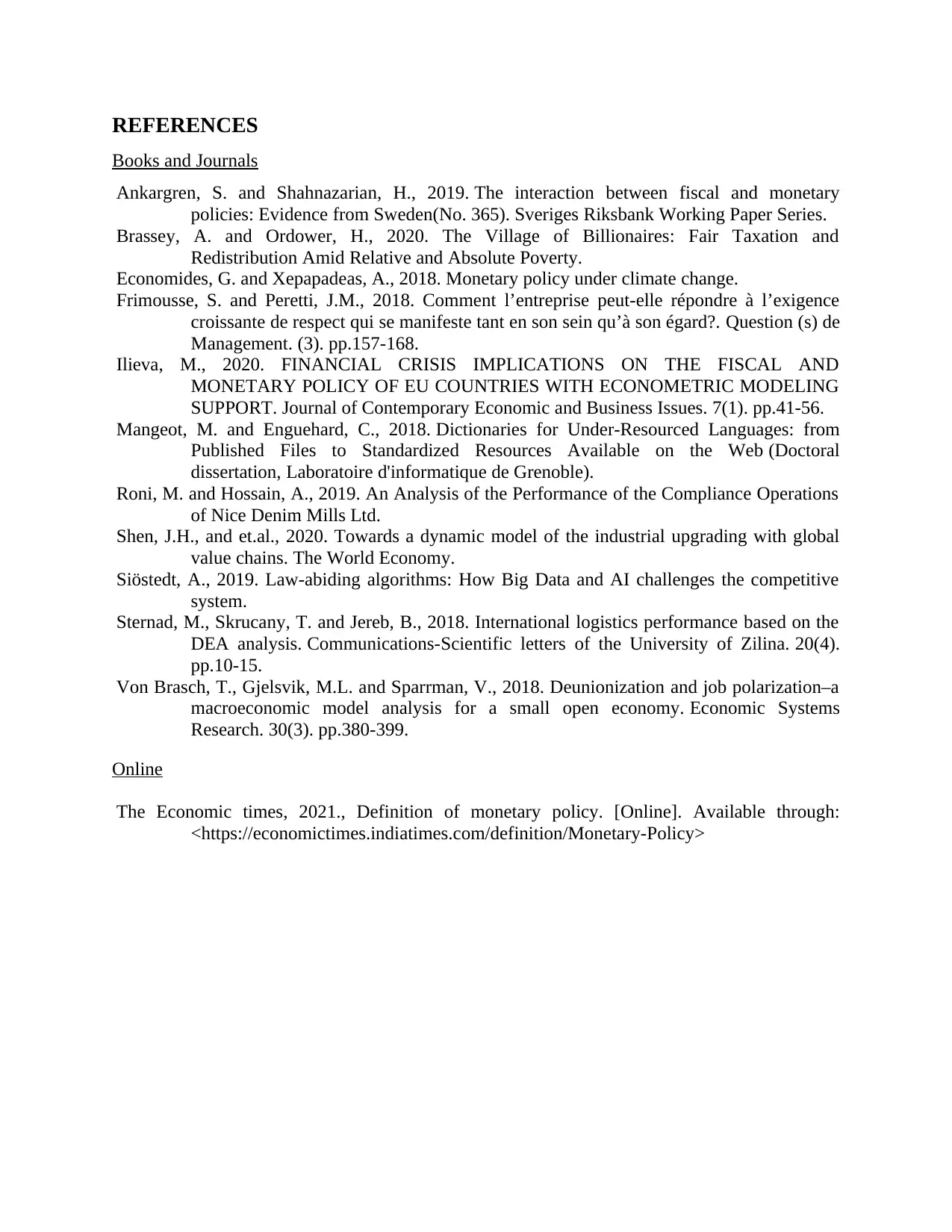
REFERENCES
Books and Journals
Ankargren, S. and Shahnazarian, H., 2019. The interaction between fiscal and monetary
policies: Evidence from Sweden(No. 365). Sveriges Riksbank Working Paper Series.
Brassey, A. and Ordower, H., 2020. The Village of Billionaires: Fair Taxation and
Redistribution Amid Relative and Absolute Poverty.
Economides, G. and Xepapadeas, A., 2018. Monetary policy under climate change.
Frimousse, S. and Peretti, J.M., 2018. Comment l’entreprise peut-elle répondre à l’exigence
croissante de respect qui se manifeste tant en son sein qu’à son égard?. Question (s) de
Management. (3). pp.157-168.
Ilieva, M., 2020. FINANCIAL CRISIS IMPLICATIONS ON THE FISCAL AND
MONETARY POLICY OF EU COUNTRIES WITH ECONOMETRIC MODELING
SUPPORT. Journal оf Contemporary Economic аnd Business Issues. 7(1). pp.41-56.
Mangeot, M. and Enguehard, C., 2018. Dictionaries for Under-Resourced Languages: from
Published Files to Standardized Resources Available on the Web (Doctoral
dissertation, Laboratoire d'informatique de Grenoble).
Roni, M. and Hossain, A., 2019. An Analysis of the Performance of the Compliance Operations
of Nice Denim Mills Ltd.
Shen, J.H., and et.al., 2020. Towards a dynamic model of the industrial upgrading with global
value chains. The World Economy.
Siöstedt, A., 2019. Law-abiding algorithms: How Big Data and AI challenges the competitive
system.
Sternad, M., Skrucany, T. and Jereb, B., 2018. International logistics performance based on the
DEA analysis. Communications-Scientific letters of the University of Zilina. 20(4).
pp.10-15.
Von Brasch, T., Gjelsvik, M.L. and Sparrman, V., 2018. Deunionization and job polarization–a
macroeconomic model analysis for a small open economy. Economic Systems
Research. 30(3). pp.380-399.
Online
The Economic times, 2021., Definition of monetary policy. [Online]. Available through:
<https://economictimes.indiatimes.com/definition/Monetary-Policy>
Books and Journals
Ankargren, S. and Shahnazarian, H., 2019. The interaction between fiscal and monetary
policies: Evidence from Sweden(No. 365). Sveriges Riksbank Working Paper Series.
Brassey, A. and Ordower, H., 2020. The Village of Billionaires: Fair Taxation and
Redistribution Amid Relative and Absolute Poverty.
Economides, G. and Xepapadeas, A., 2018. Monetary policy under climate change.
Frimousse, S. and Peretti, J.M., 2018. Comment l’entreprise peut-elle répondre à l’exigence
croissante de respect qui se manifeste tant en son sein qu’à son égard?. Question (s) de
Management. (3). pp.157-168.
Ilieva, M., 2020. FINANCIAL CRISIS IMPLICATIONS ON THE FISCAL AND
MONETARY POLICY OF EU COUNTRIES WITH ECONOMETRIC MODELING
SUPPORT. Journal оf Contemporary Economic аnd Business Issues. 7(1). pp.41-56.
Mangeot, M. and Enguehard, C., 2018. Dictionaries for Under-Resourced Languages: from
Published Files to Standardized Resources Available on the Web (Doctoral
dissertation, Laboratoire d'informatique de Grenoble).
Roni, M. and Hossain, A., 2019. An Analysis of the Performance of the Compliance Operations
of Nice Denim Mills Ltd.
Shen, J.H., and et.al., 2020. Towards a dynamic model of the industrial upgrading with global
value chains. The World Economy.
Siöstedt, A., 2019. Law-abiding algorithms: How Big Data and AI challenges the competitive
system.
Sternad, M., Skrucany, T. and Jereb, B., 2018. International logistics performance based on the
DEA analysis. Communications-Scientific letters of the University of Zilina. 20(4).
pp.10-15.
Von Brasch, T., Gjelsvik, M.L. and Sparrman, V., 2018. Deunionization and job polarization–a
macroeconomic model analysis for a small open economy. Economic Systems
Research. 30(3). pp.380-399.
Online
The Economic times, 2021., Definition of monetary policy. [Online]. Available through:
<https://economictimes.indiatimes.com/definition/Monetary-Policy>
1 out of 10
Related Documents
Your All-in-One AI-Powered Toolkit for Academic Success.
+13062052269
info@desklib.com
Available 24*7 on WhatsApp / Email
![[object Object]](/_next/static/media/star-bottom.7253800d.svg)
Unlock your academic potential
Copyright © 2020–2025 A2Z Services. All Rights Reserved. Developed and managed by ZUCOL.





